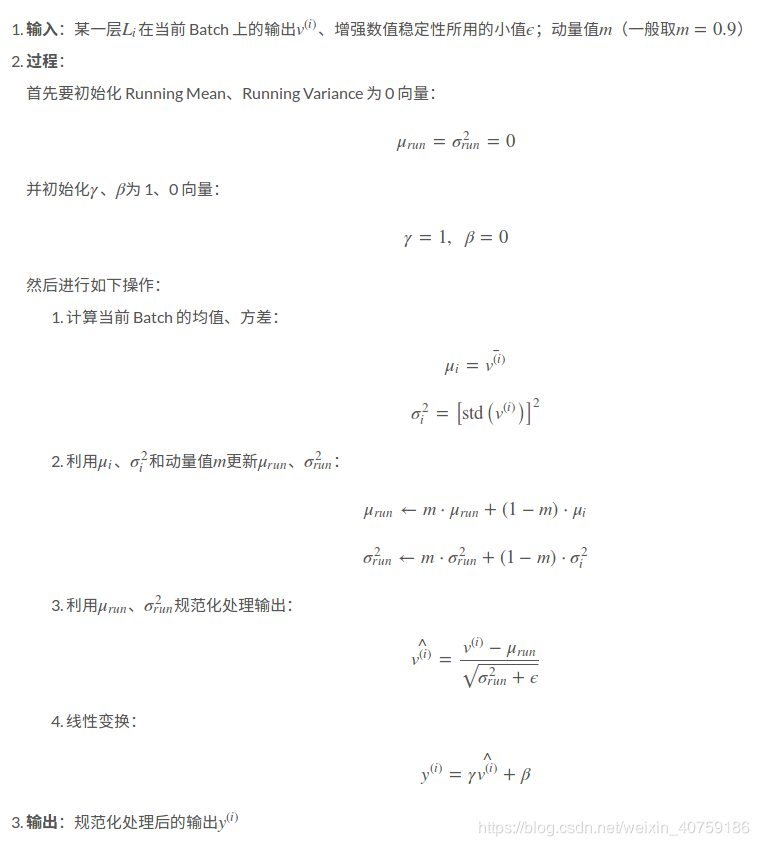小编给大家分享一下如何解决Pytorch中Batch Normalization layer的问题,相信大部分人都还不怎么了解,因此分享这篇文章给大家参考一下,希望大家阅读完这篇文章后大有收获,下面让我们一起去了解一下吧!
Pytorch中的BN层的动量平滑和常见的动量法计算方式是相反的,默认的momentum=0.1

BN层里的表达式为:

其中γ和β是可以学习的参数。在Pytorch中,BN层的类的参数有:
CLASS torch.nn.BatchNorm2d(num_features, eps=1e-05, momentum=0.1, affine=True, track_running_stats=True)
每个参数具体含义参见文档,需要注意的是,affine定义了BN层的参数γ和β是否是可学习的(不可学习默认是常数1和0).
track_running_stats – a boolean value that when set to True, this module tracks the running mean and variance, and when set to False, this module does not track such statistics and always uses batch statistics in both training and eval modes. Default: True
在训练过程中model.train(),train过程的BN的统计数值—均值和方差是通过当前batch数据估计的。
并且测试时,model.eval()后,若track_running_stats=True,模型此刻所使用的统计数据是Running status 中的,即通过指数衰减规则,积累到当前的数值。否则依然使用基于当前batch数据的估计值。
是在每一次训练阶段model.train()后的forward()方法中自动实现的,而不是在梯度计算与反向传播中更新optim.step()中完成
从上面的分析可以看出来,正确的冻结BN的方式是在模型训练时,把BN单独挑出来,重新设置其状态为eval (在model.train()之后覆盖training状态).
解决方案:
You should use apply instead of searching its children, while named_children() doesn't iteratively search submodules.
def set_bn_eval(m):
classname = m.__class__.__name__
if classname.find('BatchNorm') != -1:
m.eval()
model.apply(set_bn_eval)或者,重写module中的train()方法:
def train(self, mode=True):
"""
Override the default train() to freeze the BN parameters
"""
super(MyNet, self).train(mode)
if self.freeze_bn:
print("Freezing Mean/Var of BatchNorm2D.")
if self.freeze_bn_affine:
print("Freezing Weight/Bias of BatchNorm2D.")
if self.freeze_bn:
for m in self.backbone.modules():
if isinstance(m, nn.BatchNorm2d):
m.eval()
if self.freeze_bn_affine:
m.weight.requires_grad = False
m.bias.requires_grad = False解决办法:
import torch
import torch.nn as nn
from torch.nn import init
from torchvision import models
from torch.autograd import Variable
from apex.fp16_utils import *
def fix_bn(m):
classname = m.__class__.__name__
if classname.find('BatchNorm') != -1:
m.eval()
model = models.resnet50(pretrained=True)
model.cuda()
model = network_to_half(model)
model.train()
model.apply(fix_bn) # fix batchnorm
input = Variable(torch.FloatTensor(8, 3, 224, 224).cuda().half())
output = model(input)
output_mean = torch.mean(output)
output_mean.backward()Please do
def fix_bn(m):
classname = m.__class__.__name__
if classname.find('BatchNorm') != -1:
m.eval().half()Reason for this is, for regular training it is better (performance-wise) to use cudnn batch norm, which requires its weights to be in fp32, thus batch norm modules are not converted to half in network_to_half. However, cudnn does not support batchnorm backward in the eval mode , which is what you are doing, and to use pytorch implementation for this, weights have to be of the same type as inputs.
补充:深度学习总结:用pytorch做dropout和Batch Normalization时需要注意的地方,用tensorflow做dropout和BN时需要注意的地方
pytorch做dropout:
就是train的时候使用dropout,训练的时候不使用dropout,
pytorch里面是通过net.eval()固定整个网络参数,包括不会更新一些前向的参数,没有dropout,BN参数固定,理论上对所有的validation set都要使用net.eval()
net.train()表示会纳入梯度的计算。
net_dropped = torch.nn.Sequential( torch.nn.Linear(1, N_HIDDEN), torch.nn.Dropout(0.5), # drop 50% of the neuron torch.nn.ReLU(), torch.nn.Linear(N_HIDDEN, N_HIDDEN), torch.nn.Dropout(0.5), # drop 50% of the neuron torch.nn.ReLU(), torch.nn.Linear(N_HIDDEN, 1), ) for t in range(500): pred_drop = net_dropped(x) loss_drop = loss_func(pred_drop, y) optimizer_drop.zero_grad() loss_drop.backward() optimizer_drop.step() if t % 10 == 0: # change to eval mode in order to fix drop out effect net_dropped.eval() # parameters for dropout differ from train mode test_pred_drop = net_dropped(test_x) # change back to train mode net_dropped.train()
net.eval()固定整个网络参数,固定BN的参数,moving_mean 和moving_var,不懂这个看下图:
if self.do_bn:
bn = nn.BatchNorm1d(10, momentum=0.5)
setattr(self, 'bn%i' % i, bn) # IMPORTANT set layer to the Module
self.bns.append(bn)
for epoch in range(EPOCH):
print('Epoch: ', epoch)
for net, l in zip(nets, losses):
net.eval() # set eval mode to fix moving_mean and moving_var
pred, layer_input, pre_act = net(test_x)
net.train() # free moving_mean and moving_var
plot_histogram(*layer_inputs, *pre_acts)
dropout和BN都有一个training的参数表明到底是train还是test, 表明test那dropout就是不dropout,BN就是固定住了BN的参数;
tf_is_training = tf.placeholder(tf.bool, None) # to control dropout when training and testing
# dropout net
d1 = tf.layers.dense(tf_x, N_HIDDEN, tf.nn.relu)
d1 = tf.layers.dropout(d1, rate=0.5, training=tf_is_training) # drop out 50% of inputs
d2 = tf.layers.dense(d1, N_HIDDEN, tf.nn.relu)
d2 = tf.layers.dropout(d2, rate=0.5, training=tf_is_training) # drop out 50% of inputs
d_out = tf.layers.dense(d2, 1)
for t in range(500):
sess.run([o_train, d_train], {tf_x: x, tf_y: y, tf_is_training: True}) # train, set is_training=True
if t % 10 == 0:
# plotting
plt.cla()
o_loss_, d_loss_, o_out_, d_out_ = sess.run(
[o_loss, d_loss, o_out, d_out], {tf_x: test_x, tf_y: test_y, tf_is_training: False} # test, set is_training=False
)
# pytorch
def add_layer(self, x, out_size, ac=None):
x = tf.layers.dense(x, out_size, kernel_initializer=self.w_init, bias_initializer=B_INIT)
self.pre_activation.append(x)
# the momentum plays important rule. the default 0.99 is too high in this case!
if self.is_bn: x = tf.layers.batch_normalization(x, momentum=0.4, training=tf_is_train) # when have BN
out = x if ac is None else ac(x)
return out当BN的training的参数为train时,只是表示BN的参数是可变化的,并不是代表BN会自己更新moving_mean 和moving_var,因为这个操作是前向更新的op,在做train之前必须确保moving_mean 和moving_var更新了,更新moving_mean 和moving_var的操作在tf.GraphKeys.UPDATE_OPS
# !! IMPORTANT !! the moving_mean and moving_variance need to be updated, # pass the update_ops with control_dependencies to the train_op update_ops = tf.get_collection(tf.GraphKeys.UPDATE_OPS) with tf.control_dependencies(update_ops): self.train = tf.train.AdamOptimizer(LR).minimize(self.loss)
以上是“如何解决Pytorch中Batch Normalization layer的问题”这篇文章的所有内容,感谢各位的阅读!相信大家都有了一定的了解,希望分享的内容对大家有所帮助,如果还想学习更多知识,欢迎关注亿速云行业资讯频道!
免责声明:本站发布的内容(图片、视频和文字)以原创、转载和分享为主,文章观点不代表本网站立场,如果涉及侵权请联系站长邮箱:is@yisu.com进行举报,并提供相关证据,一经查实,将立刻删除涉嫌侵权内容。